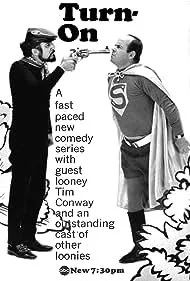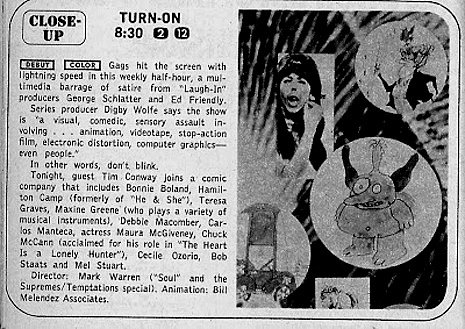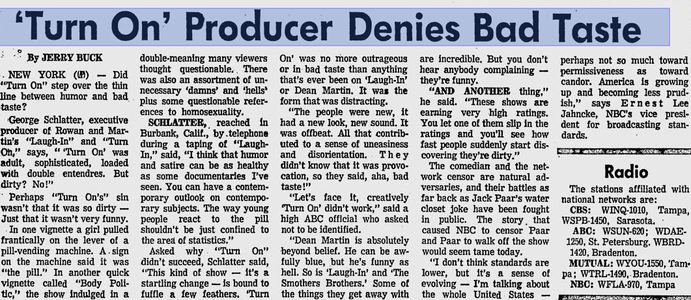Turn-On, the Infamous Laugh-In Knockoff That Was Cancelled Halfway Through Its First Episode Is On Youtube and Every Bit as Crazy and Assaultive As You'd Think
As someone who has written a column about famous failures for sixteen years now, I have long been curious about the legend of Turn-On, the infamous 1969 sketch show that was cancelled halfway through its first episode.
That’s right: Turn-On got the axe roughly fifteen minutes into what would turn out to be a thirty minute run.
It doesn’t get any worse than that. Turn-On’s debut episode was also its finale and its entire run.
I’ve head about Turn-On but I never thought I’d be able to see it and write about it because I assumed that ABC burned the only surviving copies of the show in order to purge their network of its malevolent mojo.
So you can imagine how excited I was to discover that someone had put both episodes of Turn-On on Youtube, that glorious online home of all of the world’s wonders. And also both episodes of Turn-On.
Conventional wisdom held that Turn-On’s downfall was attributable to its smuttiness and speed.
George Schlatter, the comedy kingpin behind the wildly successful Laugh-In apparently felt that if the kids liked his fast-paced, leering sketch comedy show then they would love a companion that was much faster paced and way hornier.
He was wrong! Oh sweet blessed lord was he ever young. Turn-On tried so hard to appeal to the microscopic attention spans and hip sensibilities of American kids raised on TV, TV dinners and Coca-Cola that it became a show that appealed to no one.
The show’s title has two different countercultural connotations. Turn on of course refers to sexual arousal and Turn-On would be plenty sexual even if the word “sex” didn’t flash onscreen a good fifteen times, sometimes so quickly that it borders on a subliminal message.
Turn-On was able to smuggle a LOT of sexual content onto the air because it’s so confusing, fast-paced and disorienting that I suspect that censors and studio executives didn’t understand the sex stuff enough to know that it was wildly excessive and borderline obscene.
The other, even more winking meaning of “Turn-On” involves taking drugs, specifically LSD. Turn-On seemed more intent on recreating an intense drug experience in visual and audio form than any television show before or since.
I love drugs but Turn-On was way too druggy for me. Call me crazy, but I like my trips to be nice and engaging, not a nightmare descent into a bewildering abyss.
Turn-On was, if anything, way too successful in its bid to freak out the squares. The squares in the ABC boardroom understandably took one look at Turn-On, got confused, disoriented and horny and asked aloud, “What is this shit and how on earth did it make it onto network television? How quickly can we cancel it? Immediately? Holy shit, let’s do it then!”
The infamous failure wasn’t just an assault on bourgeoisie propriety; it was an all-out assault on the senses as well. It was a blitzkrieg of sight gags and leering innuendo and double entendres and random-ass shit that doesn’t make a goddamn bit of sense but amused the dopers writing this nonsense when they’d get blazed on sweet reefer before every writing/smoke session.
Turn-On’s primary weapon in its war on squares was speed. The show disastrously hypothesized that if audiences loved a show that changed scenes and sets and cast members every thirty seconds to a minute then they’d be crazy about one that sped through sketches in a mere manner of seconds.
There’s a good reason even the fastest comedy doesn’t change scenes fifteen times a minute: it’s damn near impossible to successfully deliver a gag in such a small amount of time and also that kind of rapid cutting literally makes audiences feel like they’re losing their minds.
I had to take a break between the first episode and the second because the show is such a wildly excessive mindfuck that I needed a good hour or so just to process what I’d seen.
I can’t even tell whether I liked Turn-On or not because I was so overwhelmed by it. I’ve legitimately never seen anything like it for very good reasons.
Turn-On attacks television conventions in a way that’s at once audacious, brave, pointless and suicidal. Rather than have the credits run at the beginning and the end, for example, credits run throughout the episode.
That is certainly original but it’s also pointless and adds to the sensation that what you’re watching makes no sense, should not exist and is making you feel like you’re having a psychotic episode and also are on all the drugs in the world and it’s not going well.
Throughout the first episode of Turn-On I found myself wondering if a particular blackout gag didn’t amuse me, let alone make me laugh, because I didn’t understand it or because it wasn’t funny or because it didn’t make sense or because it wasn’t even a joke, but rather a random bit of chicanery.
Another area in which Turn-On deviates strongly from the norm is in its use of music. For reasons I cannot begin to fathom, the legendary disaster favors weird electronic music that is unnerving and disturbing on every level.
Instead of putting me in the mood to laugh, these distant cousins of Lou Reed’s notorious Metal Machine Music made me want to climb out of my skin and leap from the nearest tall building to my death.
H.P. Lovecraft sometimes wrote about sounds so unholy, so evil and so overwhelming that they defied understanding and comprehension. That’s a good definition of Turn-On’s electronic score. It’s not just staggeringly inappropriate; it will give you hives.
If anything in Turn-On were funny its comedy-killing score would smother any potential laughs.
When you’re trying to make people laugh you want music that serves the comedy and not ominous synthesizer squiggles that make you feel like you’ve taken way too much LSD and are going insane.
The show regularly uses synth notes the way a conventional show would use a rimshot or a sound effect. This only adds to the sense that Turn-On was created by space aliens who do not understand humanity or comedy yet felt compelled to mount a comedy show starring humans all the same.
The premise of Turn-On was that it was the first show created by a computer and that this artificial intelligence is calling the shots. Judging by the show’s pace and tone this computer is either freebasing Crystal meth or sniffing glue because there is something very wrong with it.
I’m not sure that I’ve ever seen anything like Turn-On, and that includes Laugh-In, the show whose zeitgeist-capturing success it was clearly trying to piggy back on.
Laugh-In was a conventional sketch comedy show in hipster hippie garb. Turn-On, in sharp contrast feels too hippie for hippies and too hip for hipsters. It thought the world needed a brand new version of Laugh-In that was hornier and faster paced. It turns out that Laugh-In was already too quick and too voyeuristic. Super-charging both of those qualities was both madness and an invitation to madness, for audiences and the show alike.
Turn-On could get really gross. One of its longer bits involves a man in a wedding dress reading a letter seeking advice from a woman who had three friends be sexually assaulted. With a leering smile, the man instructs her not to get discouraged and to wear tight clothing and hang out in crime-ravaged neighborhoods so that she too can know the pleasure of being sexually assaulted by a stranger.
The punchline is that women want to be raped. You don’t need to be a prude to think a scene like that does not belong on network television in prime time or anywhere, for that matter.
Turn-On was not too hip or too drugged out for variety show staples like sketches about cops and rednecks. The eminently dependable Chuck McCann, weirdly the biggest name in the cast, is a natural in those kinds of parts but the editing and scoring are so aggressive and invasive that we wouldn’t even have time to laugh even if anything in Turn-On was funny.
Aside from Schlatter and McCann, the only name in the cast or crew of note was a twenty-two year old prodigy on the writing staff whose dad, a vaudevillian dialect comedian who performed under the name Parkyakarkus, died at a Shriner’s Roast shortly after performing (everyone agreed that he killed before dying).
That’s right: Turn-On was the first TV or movie writing gig for a young Albert Brooks. I can only imagine the kind of amazing anecdotes Brooks must have gotten from this uniquely cursed early gig but while I’m very grateful that I got to experience this waking nightmare, this televisual bad trip but I’m not holding my breath for an official release with an audio commentary from Brooks.
But a man can sure dream, can’t he?
Failure, Fiasco or Secret Success: Fiasco
Check out The Joy of Trash: Flaming Garbage Fire Extended Edition at https://www.nathanrabin.com/shop and get a free, signed "Weird Al” Yankovic-themed coloring book for free! Just 18.75, shipping and taxes included! Or, for just 25 dollars, you can get a hardcover “Joy of Positivity 2: The New Batch” edition signed (by Felipe and myself) and numbered (to 50) copy with a hand-written recommendation from me within its pages. It’s truly a one-of-a-kind collectible!
I’ve also written multiple versions of my many books about “Weird Al” Yankovic that you can buy here: https://www.nathanrabin.com/shop
Or you can buy The Joy of Trash from Amazon at https://www.amazon.com/Joy-Trash-Nathan-Definitive-Everything/dp/B09NR9NTB4/ref=tmm_pap_swatch_0?_encoding=UTF8&qid=&sr= but why would you want to do that?
Check out my new Substack at https://nathanrabin.substack.com/
And we would love it if you would pledge to the site’s Patreon as well. https://www.patreon.com/nathanrabinshappyplace











